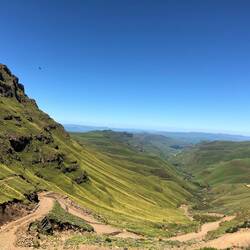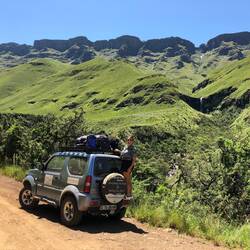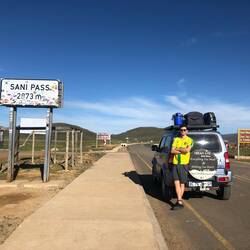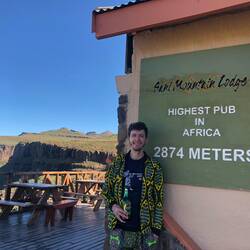Livingstone- Devil’s Pool
 January 9, 2020 in Zambia ⋅ ☁️ 26 °C
January 9, 2020 in Zambia ⋅ ☁️ 26 °C
If you were to tell someone that today we were going to get in a speedboat that would thrash towards the edge of the largest waterfall in Africa, before disembarking, swimming against currents thatRead more
Livingstone to Lusaka
 January 10, 2020 in Zambia ⋅ ☁️ 27 °C
January 10, 2020 in Zambia ⋅ ☁️ 27 °C
Another long-distance coach journey. They’re never the most fun, but it’s all part of the adventure, and you certainly feel more connected to the country than if we were to fly 33,000ft aboveRead more
Lusaka to Lilongwe
 January 12, 2020 in Malawi ⋅ 🌧 27 °C
January 12, 2020 in Malawi ⋅ 🌧 27 °C
Early start again to get the 6am bus to Lilongwe. There is only one bus company that plies the Lusaka to Lilongwe route, so we take that one, and hope for the best.
Today’s bus surprise is a smallRead more
Lilongwe
 January 13, 2020 in Malawi ⋅ ☁️ 25 °C
January 13, 2020 in Malawi ⋅ ☁️ 25 °C
There’s not much to say about Lilongwe, since honestly there’s not much to do here. But I guess it’s fair to say we are a Lilongwe from home.
The city is spread out, with none of it feelingRead more
Lilongwe to Nkhata Bay
 January 15, 2020 in Malawi ⋅ 🌧 27 °C
January 15, 2020 in Malawi ⋅ 🌧 27 °C
The latest in a series of sketchy African coach journeys, this one from Lilongwe to Nkhata Bay, a small tourist town on Lake Malawi.
The coach, due to set off at 11pm, doesn’t arrive until pastRead more
Nkhata Bay
 January 19, 2020 in Malawi ⋅ ☁️ 30 °C
January 19, 2020 in Malawi ⋅ ☁️ 30 °C
Mayoka Village, perched on the edge of Lake Malawi, has to be one of the best places we have stayed so far. A series of little houses and bungalows seem to tumble down the hill, threatening to spillRead more
Living with Phillip & his family
 January 20, 2020 in Malawi ⋅ ☁️ 32 °C
January 20, 2020 in Malawi ⋅ ☁️ 32 °C
Morning starts off early and rushed with breakfast at 7am and set off from Mayoka Village at 7:15. Today, we are headed to Chimbota Secondary School, a private high school in the village of ChimbotaRead more
Nhkata Bay to Livingstonia
 January 24, 2020 in Malawi ⋅ 🌧 23 °C
January 24, 2020 in Malawi ⋅ 🌧 23 °C
It’s time for a change in scenery. Since we’ve been in Nhkata Bay for a bit longer than expected we decide to pack up our stuff and to the North of Malawi to Livingstonia. We plan to stay at aRead more
Livingstonia
 January 25, 2020 in Malawi ⋅ ☁️ 26 °C
January 25, 2020 in Malawi ⋅ ☁️ 26 °C
We wake from a good night’s sleep, and emerge from our safari tent onto our private balcony. The decking is built directly on top of the cliff, so we can look directly out over the lake shore, allRead more
MV Ilala
 January 27, 2020 in Malawi ⋅ ☁️ 28 °C
January 27, 2020 in Malawi ⋅ ☁️ 28 °C
Today we are boarding the MV Ilala, a ferry that has been cruising Lake Malawi since 1951, for what promises to be one of the great African boat adventures.
In the morning, we head down to the ferryRead more
Likoma Island
 January 28, 2020 in Malawi ⋅ 🌧 25 °C
January 28, 2020 in Malawi ⋅ 🌧 25 °C
Early in the morning, the Ilala moors up alongside Likoma Island, a small island a stone’s throw from the Mozambican shoreline (though, I suppose, everywhere is a stone’s throw away when you haveRead more
MV Chambo
 January 29, 2020 in Mozambique ⋅ ☁️ 26 °C
January 29, 2020 in Mozambique ⋅ ☁️ 26 °C
Today, we are heading back to the mainland. Since the MV Ilala is continuing on it’s route to the south of the lake, we are taking the MV Chambo, a smaller boat that navigates the shorter route fromRead more
Malawi- Mozambique: Journey from Hell
 January 31, 2020 in Malawi ⋅ ☁️ 22 °C
January 31, 2020 in Malawi ⋅ ☁️ 22 °C
Today, we must cross from Malawi into Mozambique, a journey we’ve been dreading, given the huge distances, and what promises to be a difficult border crossing.
We say our goodbyes to the staff atRead more
Tofo- Ocean Safari
 February 4, 2020 in Mozambique ⋅ ⛅ 29 °C
February 4, 2020 in Mozambique ⋅ ⛅ 29 °C
Another day, another safari. This time, we’re off out on the ocean (Indian version) from the small town of Tofo. Everyone is looking for Whale Sharks (and you are offered a free trip the next day ifRead more
Surfin’ Mozambique
 February 6, 2020 in Mozambique ⋅ ⛅ 29 °C
February 6, 2020 in Mozambique ⋅ ⛅ 29 °C
Surf’s up! Apparently... We don’t know too much about surfing, so we’ve booked into a lesson. Tofo is great for beginners, as the waves are relatively small, and there are no rocks or coral toRead more
A warm welcome into South Africa
 February 11, 2020 in South Africa ⋅ 🌧 2 °C
February 11, 2020 in South Africa ⋅ 🌧 2 °C
Saying goodbye to Mozambique, we board an early bus from Maputo to Johannesburg. In comparison to the other bus journeys we’ve taken, this bus can only be described as a 5-star hotel on wheels. WhoRead more
Durban
 February 14, 2020 in South Africa ⋅ ☀️ 29 °C
February 14, 2020 in South Africa ⋅ ☀️ 29 °C
Leaving Johannesburg today to head to Durban. We've enjoyed our time in Joburg much more than expected, but we've brought a few local craft beers with us in the hire car to remember the city by.Read more
Durban Day 2
 February 15, 2020 in South Africa ⋅ ⛅ 29 °C
February 15, 2020 in South Africa ⋅ ⛅ 29 °C
We wake up with a fairly bad hangover, and a nervousness from last night's events. We're not too keen to explore Durban, especially since one of our friends had told us prior to the trip "you onlyRead more
Up the Sani Pass to Lesotho
 February 16, 2020 in Lesotho ⋅ ☀️ 17 °C
February 16, 2020 in Lesotho ⋅ ☀️ 17 °C
Today we're leaving South Africa and heading into the mountainous country of Lesotho. To get there, we drive away from the coast and head through the Drakensberg (Dragon's Mountain) range, up to theRead more
Down the Sani Pass to Coffee Bay
 February 17, 2020 in South Africa ⋅ ⛅ 26 °C
February 17, 2020 in South Africa ⋅ ⛅ 26 °C
Leaving Lesotho today after our brief stay. We wake up early enough to watch the sunrise and consider heading further into the country, but the roads are all rough mountain passes, and although thatRead more
Surfin Coffee Bay
 February 18, 2020 in South Africa ⋅ 🌧 22 °C
February 18, 2020 in South Africa ⋅ 🌧 22 °C
A damp start to the day, as our tent has completely filled with rainwater. There's a swamp in and around our tent. No time to dry out everything though, as we've signed up for surfing lessons. TheyRead more
Jeffrey's Bay to Mossel Bay
 February 19, 2020 in South Africa ⋅ ⛅ 22 °C
February 19, 2020 in South Africa ⋅ ⛅ 22 °C
We spend the next few days heading down the coast towards the Cape. Our first stop along the way is Jeffrey's Bay, where our friends are also staying. We spend a couple of days surfing and drinkingRead more
Hermanus
 February 24, 2020 in South Africa ⋅ ☀️ 25 °C
February 24, 2020 in South Africa ⋅ ☀️ 25 °C
After Mossel Bay, we head closer to the Cape, stopping off at Hermanus, on the advice of our friend Marion.
Hermanus is a nice place. It's quite fancy which comes as a bit of a culture shock afterRead more
Franschhoek via Betty’s Bay
 February 25, 2020 in South Africa ⋅ 🌙 18 °C
February 25, 2020 in South Africa ⋅ 🌙 18 °C
Today we're heading to Franschhoek, one of the famous South African wine valleys. We take the scenic route, around the eastern side of False Bay, and we do not regret it.
First stop is Betty's Bay,Read more
Franschhoek Wine Tram
 February 26, 2020 in South Africa ⋅ ☀️ 27 °C
February 26, 2020 in South Africa ⋅ ☀️ 27 °C
The Western Cape of South Africa- the area around Cape Town- is famous for its wines. In the early 1700s, French Hugenots fled here, escaping persecution. They brought with them their knowledge ofRead more


































































































